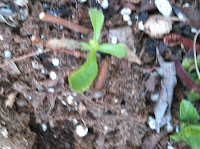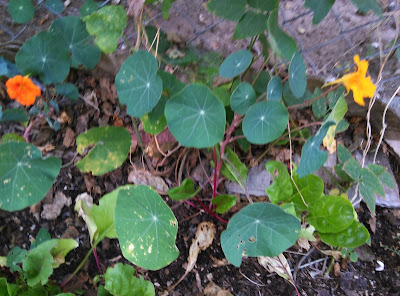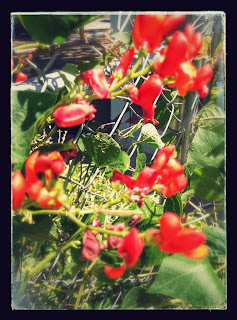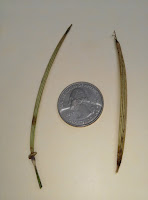Remember when I was talking about the theme of
getting things right, in
part 1 of this series? Now you're going to find out how my experience with chayote squash made me question whether it's ever possible to learn the truth about anything.
Having watched a
youtube video about how to sprout chayotes, I felt quite confident when I set two of them -- purchased at a supermarket, not stolen -- in a sunny spot to sprout. After waiting for weeks and then buying two more chayotes at Downtown L.A.'s Grand Central Market, I decided it was time for more research. Trying the same approach with the second pair, I reasoned, was something like throwing good money (79¢) after bad ($1.98). And so I went back to
youtube and watched someone put a chayote into a brown paper bag and stash it in a cool dark place, coming back in a few days to find a bag full of leafiness. Aha! Here was a new approach I must try. Not having a paper bag of the right size to hold all four chayotes, I located a cardboard box that was just right for three. It fit nicely on a shelf in our cool dark linen closet. This was the point at which we ate one of the supermarket chayotes.
"Where are the links to those two
youtube videos?" you are probably asking. Ordinarily I like to give my readers a lot of helpful links, but obviously these two were not helpful. In fact, I didn't see or read anything worth recommending until
after the three chayotes were planted in the garden.
So . . . back to the linen closet. I think it's time to simplify this narrative by naming the fruits. ONE of the chayotes starting sprouting nicely after about a week; let's call it
C1. Another (
C2) showed no signs of any change, but one of them (
C3) was seriously shriveling. I looked at more
youtube videos, hoping to see something about how chayote roots were supposed to develop. What I saw was chayotes being put into pots with their flat, unsprouted sides down and soil drawn up around them. Most of the top sides were uncovered.
It must have been late December by now, because this was when I announced on an on-line forum that I had put two of them (C1 and C3) in pots and put them on the back porch where they'd get some sun and possibly put down some roots. I don't remember whether C2 stayed in the linen closet or not.
On January 8 or 9, according to my forum, I planted C1 next to my neighbor's fence. It was gratifying to see that a long tap root had developed and was supplemented by lots of hairy feeder roots
C3 was set out a couple of feet from C1 on January 13, while C2 remained in a pot on the bathroom window sill until February 2.
Meanwhile C1 was reaching for the top of my neighbor's fence. This fence, which starts where our chain link fence stops, runs along the south side of our property. Her ex-husband built it at least 20 years ago out of wooden two-by-fours resting on the concrete walkway to their back yard. He finished the fence on their side with a stucco covering painted to match their house Because we wanted to grow vines on our side, we covered it with white plastic trellis through which we can see some termite damage which, though it has been treated by an exterminator, has weakened the fence to a certain extent.
It was AFTER all the chayotes were planted along this north-facing fence and AFTER I'd proudly told our neighbor that they would soon come spilling over the top (fortunately she likes chayotes), that I found an article in
Mother Earth News of November/December 1980: "
Growing Chayote." According to a teaser right after the title: "Growing chayote is a great option if you live in a warm or tropical climate. Once established, a single plant can bear 50 to 100 fruits a season." The article also states that individual chayotes fruits can weigh up to a pound each. In other words, I was about to subject an old, weakened fence we didn't even own to a potential load of 300 pounds, plus the weight of the vines. What was I thinking?
Chayote chaos indeed!

















